
《旅游学概论(双语)》课程教学大纲 一、课程基本信息 课程代码:21080033 课程名称:旅游学概论(双语 英文名称:Introduction to Tourism Studies 课程类别:基础课 学 时:45 学 分:3 适用对象:旅游管理、酒店管理、会展管理本科生 考核方式:考试 先修课程:管理学、市场营销学、财务管理等 二、课程简介 本课程是旅游管理专业的基础课,主要研究旅游系统的各个要素及其相互关系的 一门学科。其主要内容包括旅游发展史、旅游系统、旅游目的地、旅游业、旅游需求、 旅游营销、旅游对社会、经济、文化、环境等方面的影响,以及世界旅游业发展趋势 等。通过该课程的学习,学生可以学握旅游业的基本知识和基本理论,具有初步分析 问题和解决问题的实际能力。 Introduction to Tourism Studies is a basic course of tourism management major,which mainly studies tourism ystem and their relationship of the elements of tourism system.This cours mainly include the history of tourism development,tourism system,tourist destination,tourism sector,tourism demand.tourism marketing.the economic consequences of tourism,the environment consequences of tourism.the social and cultural consequences of tourism.and tourism futures.This course can help students have a good understanding of the basic theory and knowledge of tourism,as well as have fundamental ability in analyzing and solving academic and practical problems. 三、课程性质与教学目的 课程性质:旅游管理专业的基础课 教学目的: 1.使学生了解旅游活动的产生与发展,掌握旅游发展史的阶段划分及主要特点、 主要事件: 2.认识旅游系统模型和主要组成要素: 3.认识旅游目的地的主要特征,主要要素,以及掌握旅游目的地生命周期理论 4.了解旅游对目的地的环境母影向、社会和文化量影响,掌据旅游对目的地的经济 影响: 5.掌握旅游业的主要构成,以及不同行业的基本知识: 6.了解影响旅游需求的主要因素和旅游营销的主要内容
1 《旅游学概论(双语)》课程教学大纲 一、课程基本信息 课程代码:21080033 课程名称:旅游学概论(双语) 英文名称:Introduction to Tourism Studies 课程类别:基础课 学 时:45 学 分:3 适用对象:旅游管理、酒店管理、会展管理本科生 考核方式:考试 先修课程:管理学、市场营销学、财务管理等 二、课程简介 本课程是旅游管理专业的基础课,主要研究旅游系统的各个要素及其相互关系的 一门学科。其主要内容包括旅游发展史、旅游系统、旅游目的地、旅游业、旅游需求、 旅游营销、旅游对社会、经济、文化、环境等方面的影响,以及世界旅游业发展趋势 等。通过该课程的学习,学生可以掌握旅游业的基本知识和基本理论,具有初步分析 问题和解决问题的实际能力。 Introduction to Tourism Studies is a basic course of tourism management major, which mainly studies tourism system and their relationship of the elements of tourism system. This course mainly include the history of tourism development, tourism system, tourist destination, tourism sector, tourism demand, tourism marketing, the economic consequences of tourism, the environment consequences of tourism, the social and cultural consequences of tourism, and tourism futures. This course can help students have a good understanding of the basic theory and knowledge of tourism, as well as have fundamental ability in analyzing and solving academic and practical problems. 三、课程性质与教学目的 课程性质:旅游管理专业的基础课 教学目的: 1.使学生了解旅游活动的产生与发展,掌握旅游发展史的阶段划分及主要特点、 主要事件; 2.认识旅游系统模型和主要组成要素; 3.认识旅游目的地的主要特征,主要要素,以及掌握旅游目的地生命周期理论。 4.了解旅游对目的地的环境影响、社会和文化影响,掌握旅游对目的地的经济 影响; 5.掌握旅游业的主要构成,以及不同行业的基本知识; 6.了解影响旅游需求的主要因素和旅游营销的主要内容

Teaching Objective: 1.Understanding the emergence and development of tourism activities,and awareness of the stage division.main characteristics and maior events of tourism development history: 2.Understanding the tourism system model and its main elements: 3.an appreciation of the features of tourism destination,the main elements of tourism destination,and an awareness of the tourism area life-cycle. 4.Understanding the environmental,social and cultural impacts of tourism on the destination,and grasp the economic impact of tourism on the destination: 5.Awareness of the main components of tourism and basic knowledge of different industries: 6.Understanding the main factors that affect tourism demand and the main content of tourism marketing. 四、教学内容及要求 第一章旅游精要(Chapter 1 Tourism Essentials) (一)目的与要求(Purpose and requirements) 1.使学生了解旅游的历史背景: 2.理解旅游系统的本质: 3.理解旅游学中有争议的术语: 4.掌握从供需两个方面对旅游的定义: 5.了解旅游研究和旅游实践中的重要问题。 The chapter is designed to provide you with: O an awareness of the historical background to tourism: an understanding of the nature of the tourism system. an awareness of the issues associated with the academic and practical study of tourism an appreciation of vexed terminology associated with tourism;and a knowledge of basic supply-side and demand-side definitions oftourism (二)教学内容(Content of courses) l,主要内容(Main topics of the course) 本章着重讲解旅游发展的历史及旅游学中重要的术语、定义和概念,并提供一 个旅游学学习框架。 In this chapter,we focus on the concepts,history,terminology and definitions that underpin tourism.Welso provide a framework for the study oftourism to guide you through this book. 2.基本概念和知识点(Basic concepts and knowledge points)
2 Teaching Objective: 1.Understanding the emergence and development of tourism activities, and awareness of the stage division, main characteristics and major events of tourism development history; 2.Understanding the tourism system model and its main elements; 3.an appreciation of the features of tourism destination, the main elements of tourism destination, and an awareness of the tourism area life-cycle. 4.Understanding the environmental, social and cultural impacts of tourism on the destination, and grasp the economic impact of tourism on the destination; 5.Awareness of the main components of tourism and basic knowledge of different industries; 6.Understanding the main factors that affect tourism demand and the main content of tourism marketing. 四、教学内容及要求 第一章 旅游精要(Chapter 1 Tourism Essentials) (一)目的与要求(Purpose and requirements) 1.使学生了解旅游的历史背景; 2.理解旅游系统的本质; 3. 理解旅游学中有争议的术语; 4. 掌握从供需两个方面对旅游的定义; 5.了解旅游研究和旅游实践中的重要问题。 The chapter is designed to provide you with: ● an awareness of the historical background to tourism; ● an understanding of the nature of the tourism system; ● an awareness of the issues associated with the academic and practical study of tourism; ● an appreciation of vexed terminology associated with tourism; and ● a knowledge of basic supply-side and demand-side definitions of tourism. (二)教学内容(Content of courses) 1.主要内容(Main topics of the course) 本章着重讲解旅游发展的历史及旅游学中重要的术语、定义和概念,并提供一 个旅游学学习框架。 In this chapter, we focus on the concepts, history, terminology and definitions that underpin tourism. We also provide a framework for the study of tourism to guide you through this book. 2.基本概念和知识点(Basic concepts and knowledge points)
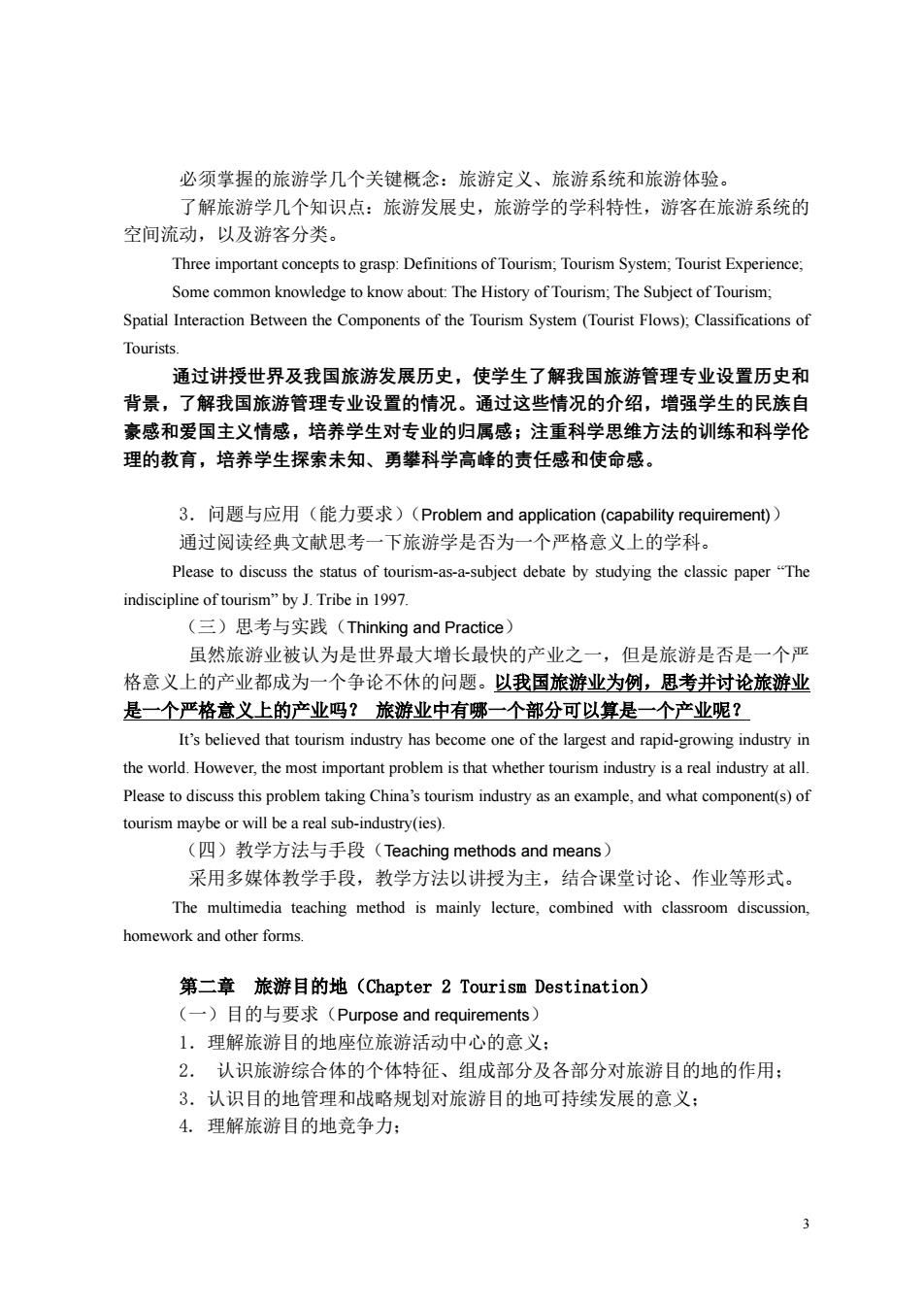
必须掌握的旅游学几个关键概念:旅游定义、旅游系统和旅游体验。 了解旅游学几个知识点:旅游发展史,旅游学的学科特性,游客在旅游系统的 空间流动,以及游客分类。 Three important concepts to grasp:Definitions of Tourism,Tourism System,Tourist Experience. Some common knowledge to know about:The History of Tourism:The Subiect of Tourism: Spatial Interaction Between the Components of the Tourism System (Tourist Flows):Classifications of Tourists. 通过讲授世界及我国旅游发展历史,使学生了解我国旅游管理专业设置历史和 背景,了解我国旅游管理专业设置的情况。通过这些情况的介绍,增强学生的民族自 豪感和爱国主义情感,培养学生对专业的归属感;注重科学思维方法的训练和科学伦 理的教育,培养学生探索未知、勇攀科学高峰的责任感和使命感。 3.问题与应用(能力要求)(Problem and application(capability requirement)) 通过阅读经典文献思考一下旅游学是否为一个严格意义上的学科。 Please to discuss the status of tourism-as-a-subject debate by studying the classic paper"The indiscipline of tourism"by J.Tribe in 1997. (三)思考与实践(Thinking and Practice 虽然旅游业被认为是世界最大增长最快的产业之一,但是旅游是否是一个严 格意义上的产业都成为一个争论不休的问题。以我国旅游业为例,思考并讨论旅游业 是一个严格意义上的产业吗?旅游业中有哪一个部分可以算是一个产业呢? It's believed that tourism industry has become one of the largest and rapid-growing industry in the world.However.the most important problem is that whether tourism industry is a real industry at all. Please to discuss this problem taking China's tourism industry as an example,and what component(s)of tourism maybe or will be a real sub-industry(ies). (四)教学方法与手段(Teaching methods and means) 采用多媒体教学手段,教学方法以讲授为主,结合课堂讨论、作业等形式。 The multimedia teaching method is mainly lecture,combined with classroom discussion, homework and other forms. 第二章旅游目的地(Chapter2 Tourism Destination) (-)目的与要求(Purpose and requirements) 1,理解旅游目的地座位旅游活动中心的意义: 2.认识旅游综合体的个体特征、组成部分及各部分对旅游目的地的作用: 3.认识目的地管理和战略规划对旅游目的地可持续发展的意义: 4.理解旅游目的地竞争力:
3 必须掌握的旅游学几个关键概念:旅游定义、旅游系统和旅游体验。 了解旅游学几个知识点:旅游发展史,旅游学的学科特性,游客在旅游系统的 空间流动,以及游客分类。 Three important concepts to grasp: Definitions of Tourism; Tourism System; Tourist Experience; Some common knowledge to know about: The History of Tourism; The Subject of Tourism; Spatial Interaction Between the Components of the Tourism System (Tourist Flows); Classifications of Tourists. 通过讲授世界及我国旅游发展历史,使学生了解我国旅游管理专业设置历史和 背景,了解我国旅游管理专业设置的情况。通过这些情况的介绍,增强学生的民族自 豪感和爱国主义情感,培养学生对专业的归属感;注重科学思维方法的训练和科学伦 理的教育,培养学生探索未知、勇攀科学高峰的责任感和使命感。 3.问题与应用(能力要求)(Problem and application (capability requirement)) 通过阅读经典文献思考一下旅游学是否为一个严格意义上的学科。 Please to discuss the status of tourism-as-a-subject debate by studying the classic paper “The indiscipline of tourism” by J. Tribe in 1997. (三)思考与实践(Thinking and Practice) 虽然旅游业被认为是世界最大增长最快的产业之一,但是旅游是否是一个严 格意义上的产业都成为一个争论不休的问题。以我国旅游业为例,思考并讨论旅游业 是一个严格意义上的产业吗? 旅游业中有哪一个部分可以算是一个产业呢? It’s believed that tourism industry has become one of the largest and rapid-growing industry in the world. However, the most important problem is that whether tourism industry is a real industry at all. Please to discuss this problem taking China’s tourism industry as an example, and what component(s) of tourism maybe or will be a real sub-industry(ies). (四)教学方法与手段(Teaching methods and means) 采用多媒体教学手段,教学方法以讲授为主,结合课堂讨论、作业等形式。 The multimedia teaching method is mainly lecture, combined with classroom discussion, homework and other forms. 第二章 旅游目的地(Chapter 2 Tourism Destination) (一)目的与要求(Purpose and requirements) 1.理解旅游目的地座位旅游活动中心的意义; 2. 认识旅游综合体的个体特征、组成部分及各部分对旅游目的地的作用; 3.认识目的地管理和战略规划对旅游目的地可持续发展的意义; 4. 理解旅游目的地竞争力;
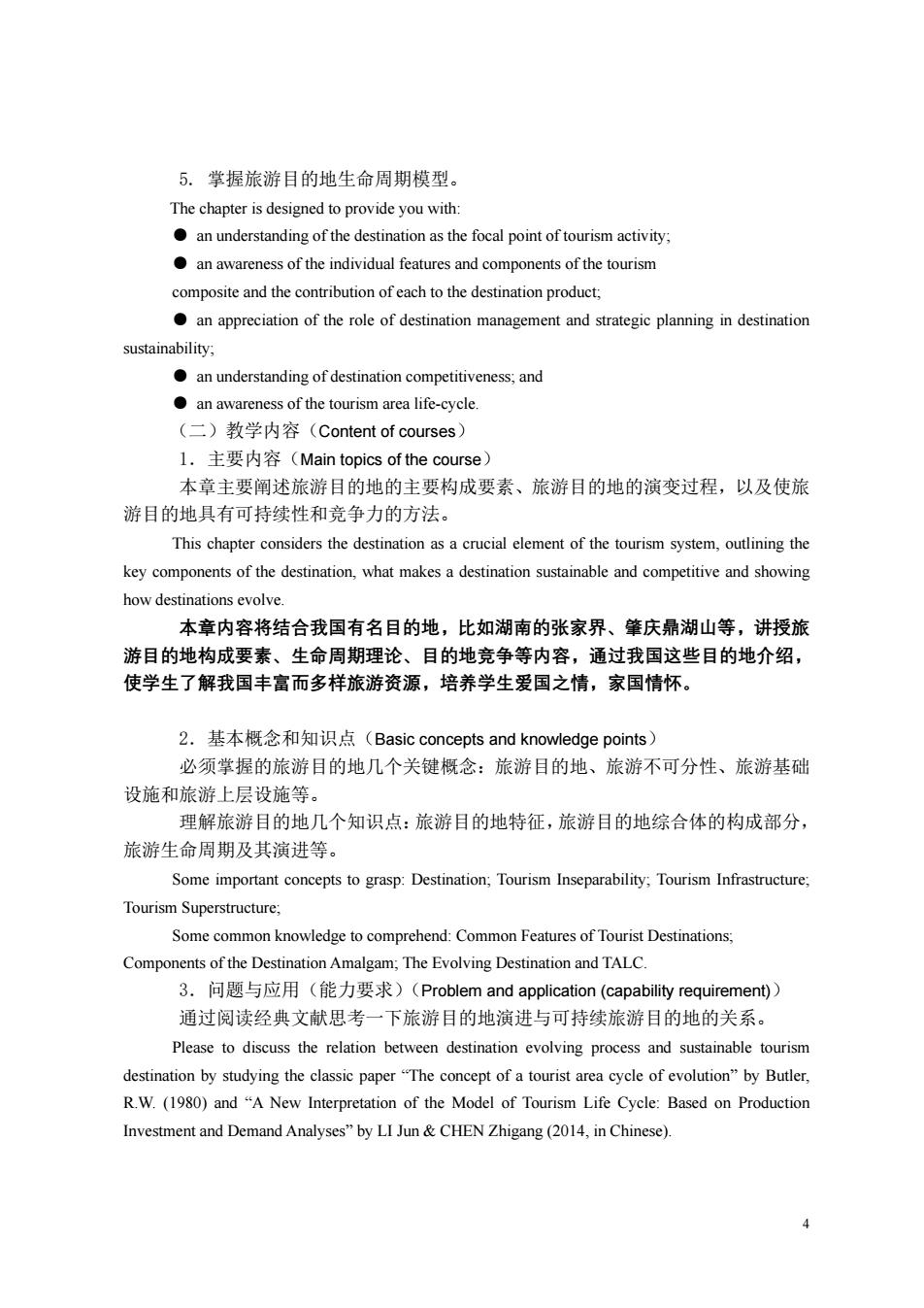
5.掌握旅游目的地生命周期模型。 The chapter is designed to provide you with: O an understanding of the destination as the focal point of tourism activity an awareness of the individual features and components of the tourism composite and the conribution of each to the destination product. an appreciation of the role of destination management and strategic planning in destination sustainability, an understanding of destination competitiveness,and an awareness of the tourism area life-cycle. (二)教学内容(Content of courses) L.主要内容(Main topics of the course) 本章主要阐述旅游目的地的主要构成要素、旅游目的地的演变过程,以及使旅 游目的地具有可持续性和竞争力的方法。 This chapter considers the destination as a crucial element of the tourism system,outlining the key components of the destination,what makes a destination sustainable and competitive and showing how destinations evolve 本章内容将结合我国有名目的地,比如湖南的张家界、肇庆鼎湖山等,讲授旅 游目的地构成要素、生命周期理论、目的地竞争等内容,通过我国这些目的地介绍, 使学生了解我国丰富而多样旅游资源,培养学生爱国之情,家国情怀。 2.基本概念和知识点(Basic concepts and knowledge points 必须掌握的旅游目的地几个关键概念:旅游目的地、旅游不可分性、旅游基础 设施和旅游上层设施等 理解旅游目的地几个知识点:旅游目的地特征,旅游目的地综合体的构成部分, 旅游生命周期及其演进等。 Some important onceptstograsp:Destination,Tourism Inseparability,Tourism Infrastructure Tourism Superstructure; Some common knowledge to comprehend:Common Features of Tourist Destinations Components of the Destination Amalgam;The Evolving Destination and TALC. 3.问题与应用(能力要求)(Problem and application(capability requirement)) 通过阅读经典文献思考一下旅游目的地演进与可持续旅游目的地的关系。 Please to discuss the relation between destination evolving process and sustainable tourism destination by studying the classic paper"The concept of a tourist area cycle of evolution"by Butler, RW.(1980)and"A New Interpretation of the Model of Tourism Life Cycle:Based on Production Investment and Demand Analyses"by LI Jun&CHEN Zhigang(2014,in Chinese)
4 5. 掌握旅游目的地生命周期模型。 The chapter is designed to provide you with: ● an understanding of the destination as the focal point of tourism activity; ● an awareness of the individual features and components of the tourism composite and the contribution of each to the destination product; ● an appreciation of the role of destination management and strategic planning in destination sustainability; ● an understanding of destination competitiveness; and ● an awareness of the tourism area life-cycle. (二)教学内容(Content of courses) 1.主要内容(Main topics of the course) 本章主要阐述旅游目的地的主要构成要素、旅游目的地的演变过程,以及使旅 游目的地具有可持续性和竞争力的方法。 This chapter considers the destination as a crucial element of the tourism system, outlining the key components of the destination, what makes a destination sustainable and competitive and showing how destinations evolve. 本章内容将结合我国有名目的地,比如湖南的张家界、肇庆鼎湖山等,讲授旅 游目的地构成要素、生命周期理论、目的地竞争等内容,通过我国这些目的地介绍, 使学生了解我国丰富而多样旅游资源,培养学生爱国之情,家国情怀。 2.基本概念和知识点(Basic concepts and knowledge points) 必须掌握的旅游目的地几个关键概念:旅游目的地、旅游不可分性、旅游基础 设施和旅游上层设施等。 理解旅游目的地几个知识点:旅游目的地特征,旅游目的地综合体的构成部分, 旅游生命周期及其演进等。 Some important concepts to grasp: Destination; Tourism Inseparability; Tourism Infrastructure; Tourism Superstructure; Some common knowledge to comprehend: Common Features of Tourist Destinations; Components of the Destination Amalgam; The Evolving Destination and TALC. 3.问题与应用(能力要求)(Problem and application (capability requirement)) 通过阅读经典文献思考一下旅游目的地演进与可持续旅游目的地的关系。 Please to discuss the relation between destination evolving process and sustainable tourism destination by studying the classic paper “The concept of a tourist area cycle of evolution” by Butler, R.W. (1980) and “A New Interpretation of the Model of Tourism Life Cycle: Based on Production Investment and Demand Analyses” by LI Jun & CHEN Zhigang (2014, in Chinese)
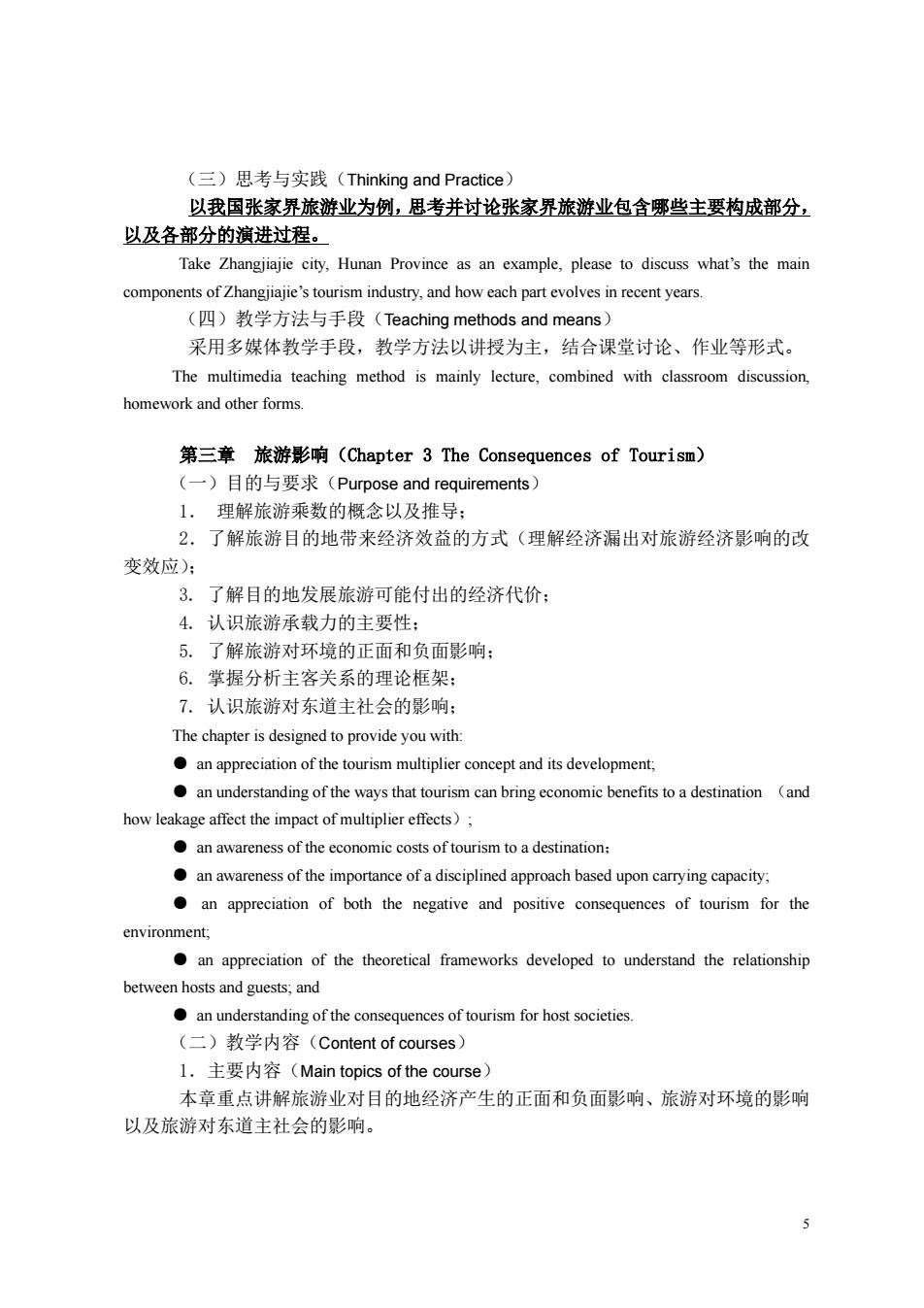
(三)思老与实践(Thinking and Practice) 以我国张家界旅游业为例,思考并讨论张家界旅游业包含哪些主要构成部分, 以及各部分的演进过程。 Take Zhangjiajie city,Hunan Province as an example,please to discuss what's the main components of Zhangiiaiie's tourism industry.and how each part evolves in recent vears. (四)教学方法与手段(Teaching methods and means) 采用多媒体教学手段,教学方法以讲授为主,结合课堂讨论、作业等形式。 The multimedia teaching method is mainly lecture.combined with classroom discussion. homework and other forms. 第三章旅游彩响(Chapter3 The Consequences of Tourism) (一)目的与要求(Purpose and requirements) 1,理解旅游乘数的概念以及推导: 2.了解旅游目的地带来经济效益的方式(理解经济漏出对旅游经济影响的改 变效应): 3.了解目的地发展旅游可能付出的经济代价 4.认识旅游承载力的主要性: 5。了解旅游对环境的正面和负面影响: 6.掌握分析主客关系的理论框架: 7.认识旅游对东道主社会的影响: The chapter is designed to provide you with an appreciation of the tourism multiplier concept and its development. an understanding of the ways that tourism can bring benefits toa destination (and how leakage affect the impact of multiplier effects); an awareness of the economic costs of tourism toa destination: an awareness of the importance of a disciplined approach based upon carrying capacity: an appreciation of both the negative and positive consequences of tourism for the environment: an appreciation of the theoretical frameworks developed to understand the relationship between hosts and guests:and an understanding of the of tourism for host societies (二)教学内容(Content of courses) L.主要内容(Main topics of the course 本章重点讲解旅游业对目的地经济产生的正面和负面影响、旅游对环境的影响 以及旅游对东道主社会的影响
5 (三)思考与实践(Thinking and Practice) 以我国张家界旅游业为例,思考并讨论张家界旅游业包含哪些主要构成部分, 以及各部分的演进过程。 Take Zhangjiajie city, Hunan Province as an example, please to discuss what’s the main components of Zhangjiajie’s tourism industry, and how each part evolves in recent years. (四)教学方法与手段(Teaching methods and means) 采用多媒体教学手段,教学方法以讲授为主,结合课堂讨论、作业等形式。 The multimedia teaching method is mainly lecture, combined with classroom discussion, homework and other forms. 第三章 旅游影响(Chapter 3 The Consequences of Tourism) (一)目的与要求(Purpose and requirements) 1. 理解旅游乘数的概念以及推导; 2.了解旅游目的地带来经济效益的方式(理解经济漏出对旅游经济影响的改 变效应); 3. 了解目的地发展旅游可能付出的经济代价; 4. 认识旅游承载力的主要性; 5. 了解旅游对环境的正面和负面影响; 6. 掌握分析主客关系的理论框架; 7. 认识旅游对东道主社会的影响; The chapter is designed to provide you with: ● an appreciation of the tourism multiplier concept and its development; ● an understanding of the ways that tourism can bring economic benefits to a destination (and how leakage affect the impact of multiplier effects); ● an awareness of the economic costs of tourism to a destination; ● an awareness of the importance of a disciplined approach based upon carrying capacity; ● an appreciation of both the negative and positive consequences of tourism for the environment; ● an appreciation of the theoretical frameworks developed to understand the relationship between hosts and guests; and ● an understanding of the consequences of tourism for host societies. (二)教学内容(Content of courses) 1.主要内容(Main topics of the course) 本章重点讲解旅游业对目的地经济产生的正面和负面影响、旅游对环境的影响 以及旅游对东道主社会的影响
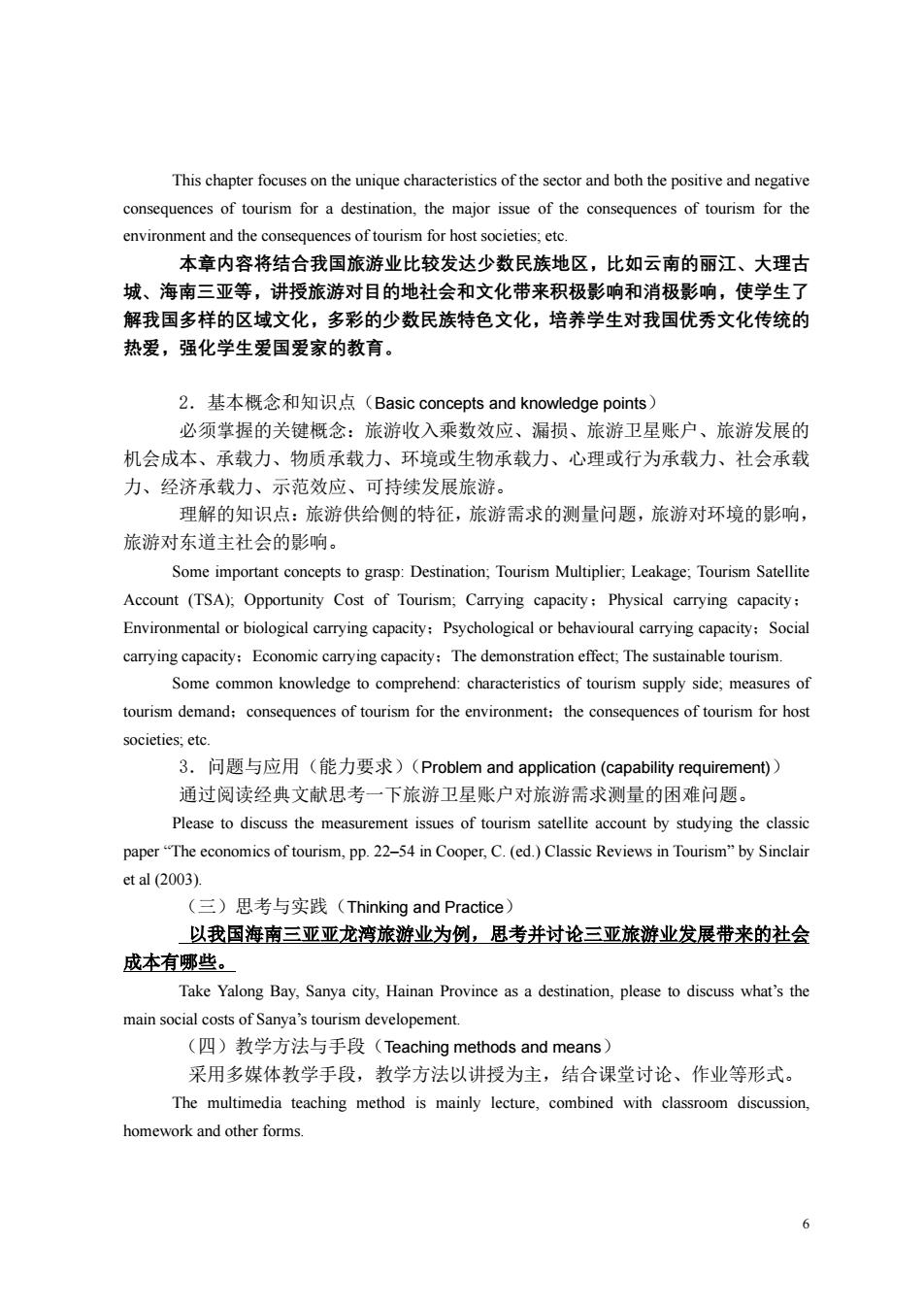
This chapter focuses on the unique characteristics of the sector and both the positive and negative consequences of tourism for a destination,the major issue of the consequences of tourism for the environment and the consequences of tourism for host societies:etc. 本章内容将结合我国旅游业比较发达少数民族地区,比如云南的丽江、大理古 城、海南三亚等,讲授旅游对目的地社会和文化带来积极影响和消极影响,使学生了 解我国多样的区域文化,多彩的少数民族特色文化,培养学生对我国优秀文化传统的 热爱,强化学生爱国爱家的教育。 2.基本概念和知识点(Basic concepts and knowledge points) 必须掌握的关键概念:旅游收入乘数效应、漏损、旅游卫星账户、旅游发展的 机会成本、承载力、物质承载力、环境或生物承载力、心理或行为承载力、社会承载 力、经济承载力、示范效应、可持续发展旅游。 理解的知识点:旅游供给侧的特征,旅游需求的测量问题,旅游对环境的影响, 旅游对东道主社会的影响。 Some important concepts to grasp:Destination.Tourism Multiplier,Leakage:Tourism Satellite Account (TSA);Opportunity Cost of Tourism:Carrying capacity:Physical carrying capacity: Environmental or biological carrying capacity:Psychological or behavioural carrying capacity:Social carrying capacity:Economic carrying capacity:The demonstration effect The sustainable tourism. Some common knowledge to comprehend:characteristics of tourism supply side,measures of tourism demand:consequences of tourism for the environment:the consequences of tourism for host societies,etc. 3.问题与应用(能力要求)(Problem and application(capability requirement))) 通过阅读经典文献思考一下旅游卫星账户对旅游需求测量的困难问题。 Please to discuss the measurement issues of tourism satellite account by studying the classic paper"The economics of tourism,pp.22-54 in Cooper,C.(ed.)Classic Reviews in Tourism"by Sinclair etal(2003) (三)思考与实践(Thinking and Practice) 以我国海南三亚亚龙湾旅游业为例,思考并讨论三亚旅游业发展带来的社会 成本有哪些。 Take Yalong Bay,Sanya city,Hainan Province as a destination,please to discuss what's the main social costs of Sanya's tourism developement. (四)教学方法与手段(Teaching methods and means) 采用多媒体教学手段,教学方法以讲授为主,结合课堂讨论、作业等形式。 The multimedia teaching method is mainly lecture,combined with classroom discussion homework and other forms
6 This chapter focuses on the unique characteristics of the sector and both the positive and negative consequences of tourism for a destination, the major issue of the consequences of tourism for the environment and the consequences of tourism for host societies; etc. 本章内容将结合我国旅游业比较发达少数民族地区,比如云南的丽江、大理古 城、海南三亚等,讲授旅游对目的地社会和文化带来积极影响和消极影响,使学生了 解我国多样的区域文化,多彩的少数民族特色文化,培养学生对我国优秀文化传统的 热爱,强化学生爱国爱家的教育。 2.基本概念和知识点(Basic concepts and knowledge points) 必须掌握的关键概念:旅游收入乘数效应、漏损、旅游卫星账户、旅游发展的 机会成本、承载力、物质承载力、环境或生物承载力、心理或行为承载力、社会承载 力、经济承载力、示范效应、可持续发展旅游。 理解的知识点:旅游供给侧的特征,旅游需求的测量问题,旅游对环境的影响, 旅游对东道主社会的影响。 Some important concepts to grasp: Destination; Tourism Multiplier; Leakage; Tourism Satellite Account (TSA); Opportunity Cost of Tourism; Carrying capacity;Physical carrying capacity; Environmental or biological carrying capacity;Psychological or behavioural carrying capacity;Social carrying capacity;Economic carrying capacity;The demonstration effect; The sustainable tourism. Some common knowledge to comprehend: characteristics of tourism supply side; measures of tourism demand;consequences of tourism for the environment;the consequences of tourism for host societies; etc. 3.问题与应用(能力要求)(Problem and application (capability requirement)) 通过阅读经典文献思考一下旅游卫星账户对旅游需求测量的困难问题。 Please to discuss the measurement issues of tourism satellite account by studying the classic paper “The economics of tourism, pp. 22–54 in Cooper, C. (ed.) Classic Reviews in Tourism” by Sinclair et al (2003). (三)思考与实践(Thinking and Practice) 以我国海南三亚亚龙湾旅游业为例,思考并讨论三亚旅游业发展带来的社会 成本有哪些。 Take Yalong Bay, Sanya city, Hainan Province as a destination, please to discuss what’s the main social costs of Sanya’s tourism developement. (四)教学方法与手段(Teaching methods and means) 采用多媒体教学手段,教学方法以讲授为主,结合课堂讨论、作业等形式。 The multimedia teaching method is mainly lecture, combined with classroom discussion, homework and other forms
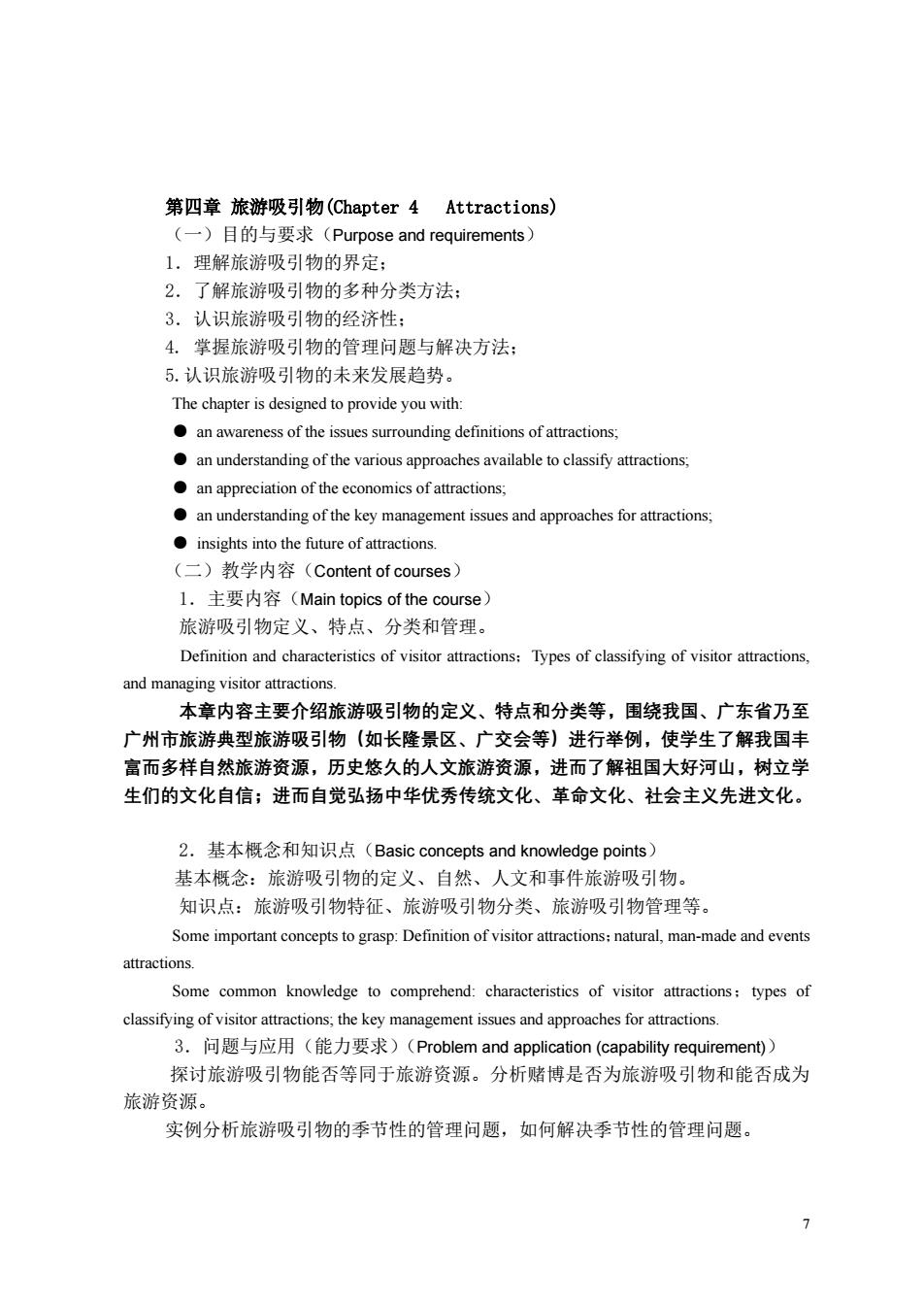
第四章旅游吸引物(Chapter4 Attractions) (一)目的与要求(Purpose and requirements) 1.理解旅游吸引物的界定: 2.了解旅游吸引物的多种分类方法: 3.认识旅游吸引物的经济性: 4.掌握旅游吸引物的管理问题与解决方法: 5.认识旅游吸引物的未来发展趋势。 The chapter is designed to provide you with: an awareness of the issues surrounding definitions of attractions; an understandingof the various approaches available to. an appreciation of the economics of attractions, an understanding of the key management issues and approaches for attractions insights into the future of attractions. (二)教学内容(Content of courses I.主要内容(Main topics of the course) 旅游吸引物定义、特点、分类和管理 Definition and characteristics of visitor attractions:Types of classifying of visitor attractions. and managing visitor attractions 本章内容主要介绍旅游吸引物的定义、特点和分类等,围绕我国、广东省乃至 广州市旅游典型旅游吸引物(如长隆景区、广交会等)进行举例,使学生了解我国丰 富而多样自然旅游资源,历史悠久的人文旅游资源,进而了解祖国大好河山,树立学 生们的文化自信;进而自觉弘扬中华优秀传统文化、革命文化、社会主义先进文化, 2.基本概念和知识点(Basic concepts and knowledge points) 基本概念:旅游吸引物的定义、自然、人文和事件旅游吸引物。 知识点:旅游吸引物特征、旅游吸引物分类、旅游吸引物管理等 Some important concepts to grasp:Definition of visitor attractions:natural,man-made and events attractions. Some common knowledge to comprehend:characteristics of visitor attractions:types of classifying of visitor attractions,the key management issues and approaches for attractions. 3.问题与应用(能力要求)(Problem and application(capability requirement)) 探讨旅游吸引物能否等同于旅游资源。分析赌博是否为旅游吸引物和能否成为 旅游资源。 实例分析旅游吸引物的季节性的管理问题,如何解决季节性的管理问题
7 第四章 旅游吸引物(Chapter 4 Attractions) (一)目的与要求(Purpose and requirements) 1.理解旅游吸引物的界定; 2.了解旅游吸引物的多种分类方法; 3.认识旅游吸引物的经济性; 4. 掌握旅游吸引物的管理问题与解决方法; 5.认识旅游吸引物的未来发展趋势。 The chapter is designed to provide you with: ● an awareness of the issues surrounding definitions of attractions; ● an understanding of the various approaches available to classify attractions; ● an appreciation of the economics of attractions; ● an understanding of the key management issues and approaches for attractions; ● insights into the future of attractions. (二)教学内容(Content of courses) 1.主要内容(Main topics of the course) 旅游吸引物定义、特点、分类和管理。 Definition and characteristics of visitor attractions;Types of classifying of visitor attractions, and managing visitor attractions. 本章内容主要介绍旅游吸引物的定义、特点和分类等,围绕我国、广东省乃至 广州市旅游典型旅游吸引物(如长隆景区、广交会等)进行举例,使学生了解我国丰 富而多样自然旅游资源,历史悠久的人文旅游资源,进而了解祖国大好河山,树立学 生们的文化自信;进而自觉弘扬中华优秀传统文化、革命文化、社会主义先进文化。 2.基本概念和知识点(Basic concepts and knowledge points) 基本概念:旅游吸引物的定义、自然、人文和事件旅游吸引物。 知识点:旅游吸引物特征、旅游吸引物分类、旅游吸引物管理等。 Some important concepts to grasp: Definition of visitor attractions;natural, man-made and events attractions. Some common knowledge to comprehend: characteristics of visitor attractions;types of classifying of visitor attractions; the key management issues and approaches for attractions. 3.问题与应用(能力要求)(Problem and application (capability requirement)) 探讨旅游吸引物能否等同于旅游资源。分析赌博是否为旅游吸引物和能否成为 旅游资源。 实例分析旅游吸引物的季节性的管理问题,如何解决季节性的管理问题
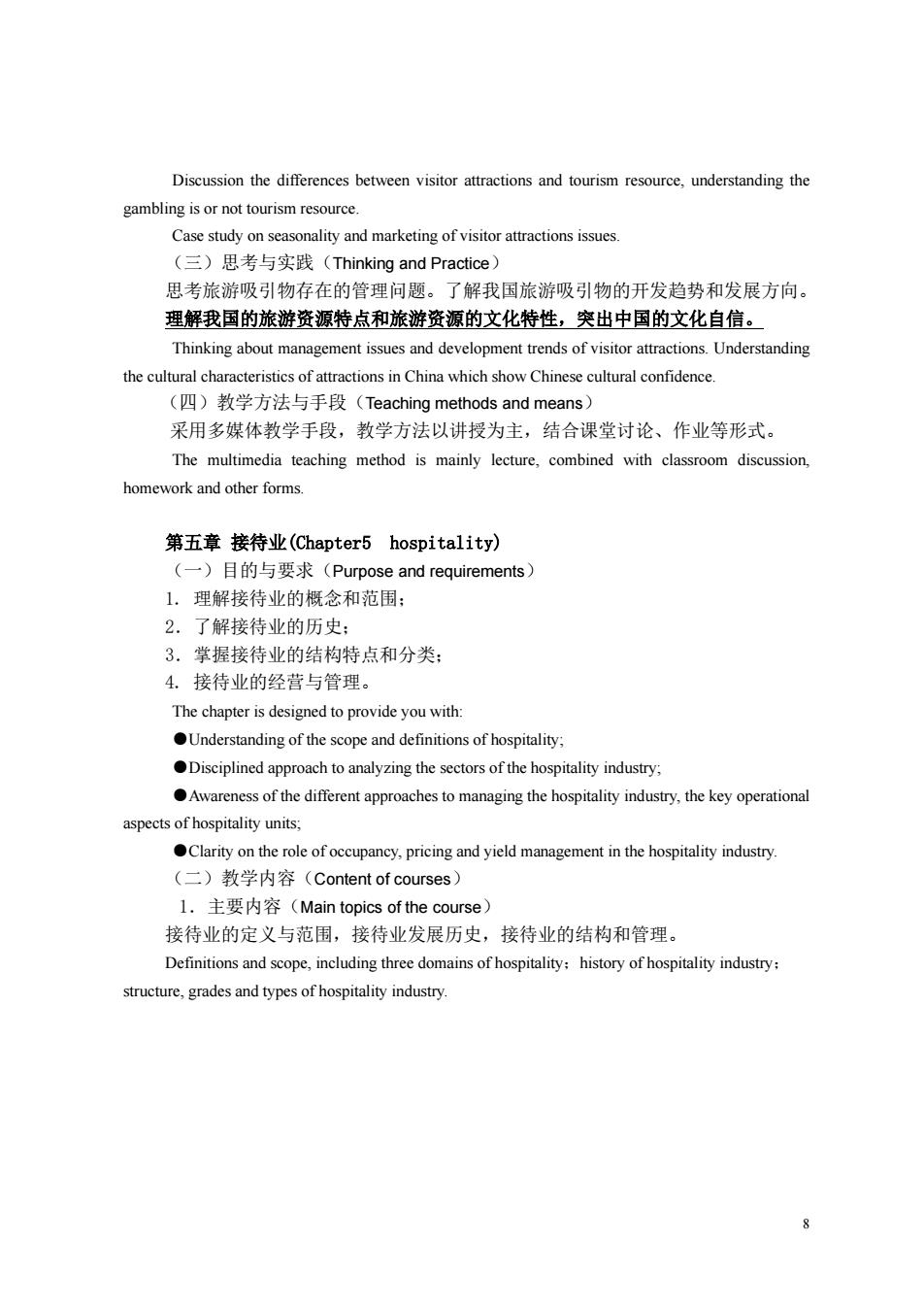
Discussion the differences between visitor attractions and tourism resource,understanding the gambling is or not tourism resource. Case study on seasonality and marketing of visitor attractions issues (三)思考与实践(Thinking and Practice) 思考旅游吸引物存在的管理问题。了解我国旅游吸引物的开发趋势和发展方向 理解我国的旅游资源特点和旅游资源的文化特性,突出中国的文化自信。 Thinking about management issues and development trends of vistor.Understanding the cultural characteristics of attractions in China which show Chinese cultural confidence (四)教学方法与手段(Teaching methods and means) 采用多媒体教学手段,教学方法以讲授为主,结合课堂讨论、作业等形式。 The multimedia teaching method is mainly lecture.combined with classroom discussion homework and other forms 第五章接待业(Chapters5 hospitality) (一)目的与要求(Purpose and requirements 1。理解接待业的概念和范围: 2.了解接待业的历史: 3.掌握接待业的结构特点和分类: 4.接待业的经营与管理。 The chapter is designed to provide you with: Understanding of the scope and definitions of hospitality. Disciplined approach to analyzing the sectors ofthe hospitality industry Awareness of the different approaches to managing the hospitality industry,the key operational aspects of hospitality units. Clarity on the role of occupancy,pricing and yield management in the hospitality industry (二)教学内容(Content of courses) L.主要内容(Main topics of the course) 接待业的定义与范围,接待业发展历史,接待业的结构和管理。 Definitions and scope,including three domains of hospitality:history of hospitality industry: structure,grades and types of hospitality industry
8 Discussion the differences between visitor attractions and tourism resource, understanding the gambling is or not tourism resource. Case study on seasonality and marketing of visitor attractions issues. (三)思考与实践(Thinking and Practice) 思考旅游吸引物存在的管理问题。了解我国旅游吸引物的开发趋势和发展方向。 理解我国的旅游资源特点和旅游资源的文化特性,突出中国的文化自信。 Thinking about management issues and development trends of visitor attractions. Understanding the cultural characteristics of attractions in China which show Chinese cultural confidence. (四)教学方法与手段(Teaching methods and means) 采用多媒体教学手段,教学方法以讲授为主,结合课堂讨论、作业等形式。 The multimedia teaching method is mainly lecture, combined with classroom discussion, homework and other forms. 第五章 接待业(Chapter5 hospitality) (一)目的与要求(Purpose and requirements) 1. 理解接待业的概念和范围; 2.了解接待业的历史; 3.掌握接待业的结构特点和分类; 4. 接待业的经营与管理。 The chapter is designed to provide you with: ●Understanding of the scope and definitions of hospitality; ●Disciplined approach to analyzing the sectors of the hospitality industry; ●Awareness of the different approaches to managing the hospitality industry, the key operational aspects of hospitality units; ●Clarity on the role of occupancy, pricing and yield management in the hospitality industry. (二)教学内容(Content of courses) 1.主要内容(Main topics of the course) 接待业的定义与范围,接待业发展历史,接待业的结构和管理。 Definitions and scope, including three domains of hospitality;history of hospitality industry; structure, grades and types of hospitality industry
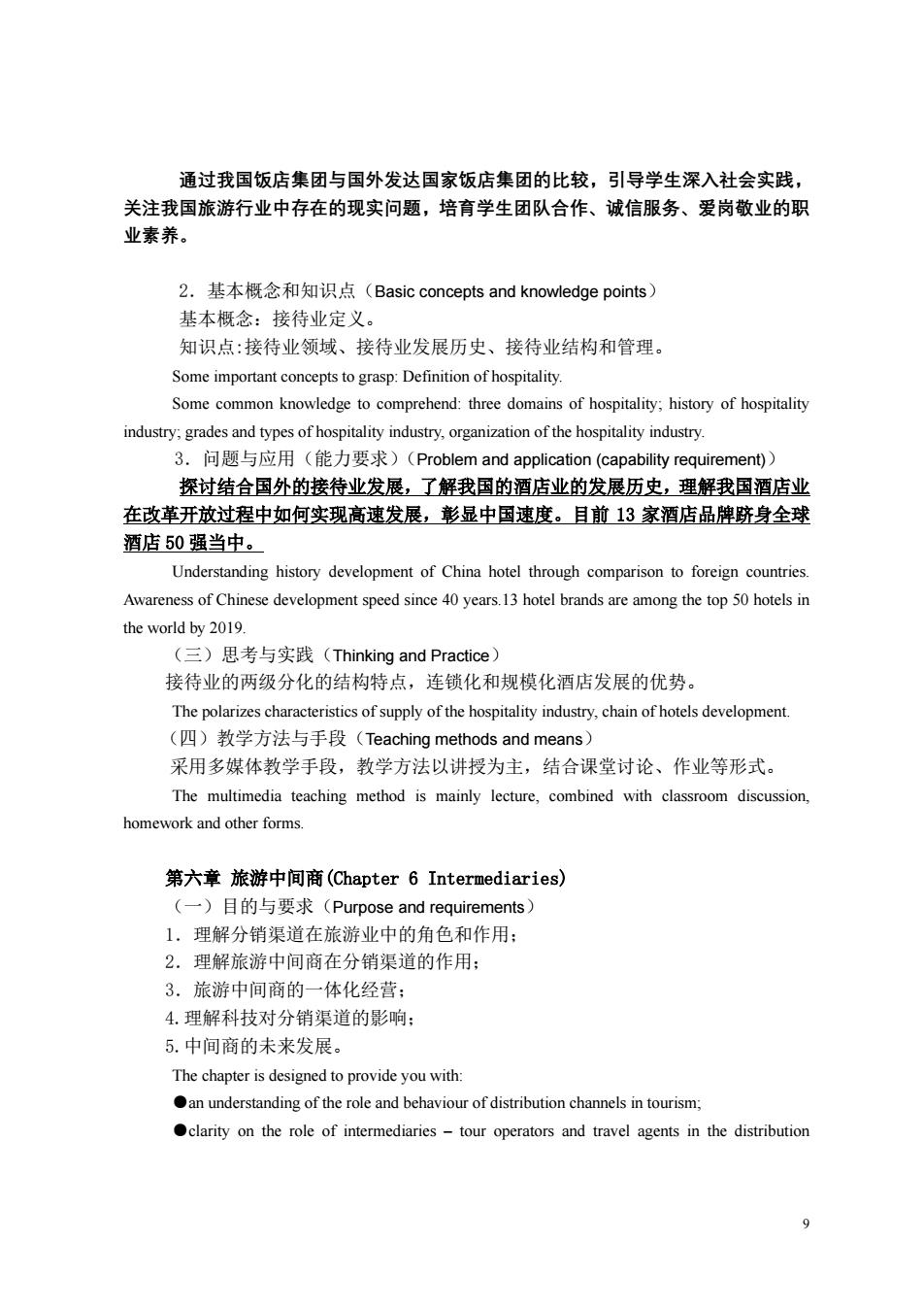
通过我国饭店集团与国外发达国家饭店集团的比较,引导学生深入社会实践, 关注我国旅游行业中存在的现实问题,培育学生团队合作、诚信服务、爱岗敬业的职 业素养。 2.基本概念和知识点(Basic concepts and knowledge points) 基本概念:接待业定义。 知识点:接待业领域、接待业发展历史、接待业结构和管理。 Some important concepts to grasp:Definition of hospitality. Some common knowledge to comprehend:three domains of hospitality:history of hospitality industry;grades and types of hospitality industry,organization of the hospitality industry. 3.问题与应用(能力要求)(Problem and application(capability requirement)) 探讨结合国外的接待业发展,了解我国的酒店业的发展历史,理解我国酒店业 在改革开放过程中如何实现高速发展,彰显中国速度。目前13家酒店品牌跻身全球 酒店50强当中。 Understanding history development of China hotel through comparison to foreign countries Awareness of Chinese development speed since 40 years.13 hotel brands are among the top 50 hotels in the world by2019. (三)思考与实践(Thinking and Practice) 接待业的两级分化的结构特点,连锁化和规模化酒店发展的优势。 The polarizes characteristics of supply of the hospitality industry,chain of hotels development. (四)教学方法与手段(Teaching methods and means 采用多媒体教学手段,教学方法以讲授为主,结合课堂讨论、作业等形式。 The multimedia teaching method is mainly lecture,combined with classroom discussion, homework and other forms. 第六章旅游中间商(Chapter6 Intermediaries) (一)目的与要求(Purpose and requirements) 1.理解分销渠道在旅游业中的角色和作用: 2.理解旅游中间商在分销渠道的作用: 3.旅游中间商的一体化经营: 4.理解科技对分销渠道的影响: 5.中间商的未来发展。 The chapter is designed to provide you with: n understanding of the role and behaviour of distribution channels in tourism clarity on the role of intermediaries-tour operators and travel agents in the distribution
9 通过我国饭店集团与国外发达国家饭店集团的比较,引导学生深入社会实践, 关注我国旅游行业中存在的现实问题,培育学生团队合作、诚信服务、爱岗敬业的职 业素养。 2.基本概念和知识点(Basic concepts and knowledge points) 基本概念:接待业定义。 知识点:接待业领域、接待业发展历史、接待业结构和管理。 Some important concepts to grasp: Definition of hospitality. Some common knowledge to comprehend: three domains of hospitality; history of hospitality industry; grades and types of hospitality industry, organization of the hospitality industry. 3.问题与应用(能力要求)(Problem and application (capability requirement)) 探讨结合国外的接待业发展,了解我国的酒店业的发展历史,理解我国酒店业 在改革开放过程中如何实现高速发展,彰显中国速度。目前 13 家酒店品牌跻身全球 酒店 50 强当中。 Understanding history development of China hotel through comparison to foreign countries. Awareness of Chinese development speed since 40 years.13 hotel brands are among the top 50 hotels in the world by 2019. (三)思考与实践(Thinking and Practice) 接待业的两级分化的结构特点,连锁化和规模化酒店发展的优势。 The polarizes characteristics of supply of the hospitality industry, chain of hotels development. (四)教学方法与手段(Teaching methods and means) 采用多媒体教学手段,教学方法以讲授为主,结合课堂讨论、作业等形式。 The multimedia teaching method is mainly lecture, combined with classroom discussion, homework and other forms. 第六章 旅游中间商(Chapter 6 Intermediaries) (一)目的与要求(Purpose and requirements) 1.理解分销渠道在旅游业中的角色和作用; 2.理解旅游中间商在分销渠道的作用; 3.旅游中间商的一体化经营; 4.理解科技对分销渠道的影响; 5.中间商的未来发展。 The chapter is designed to provide you with: ●an understanding of the role and behaviour of distribution channels in tourism; ●clarity on the role of intermediaries – tour operators and travel agents in the distribution
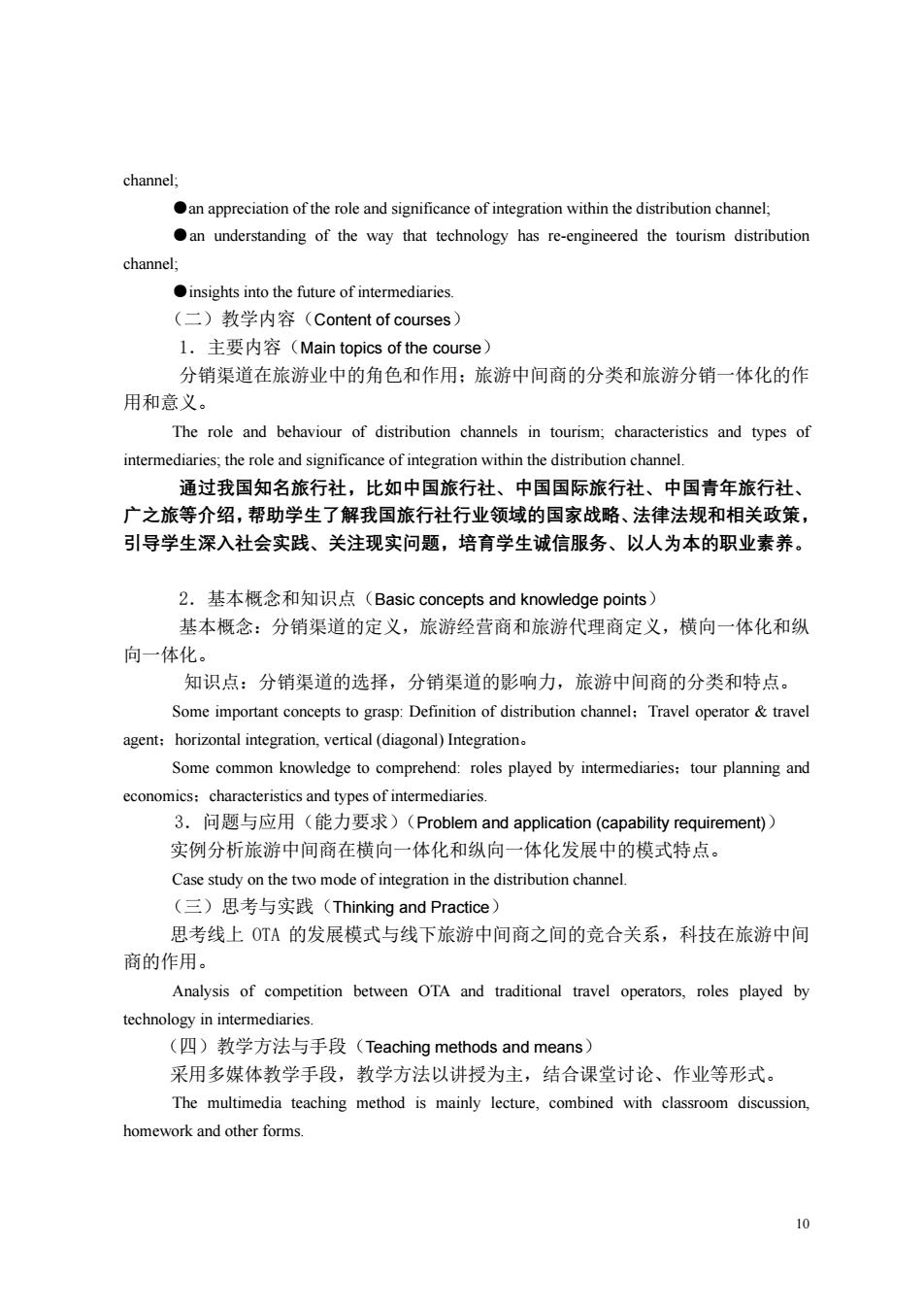
channel; an appreciation of the role and significance of integration within the distribution channel, an understanding of the way that technology has re-engineered the tourism distribution channel; insights into the future of intermediaries (二)教学内容(Content of courses) 1.主要内容(Main topics of the course) 分销渠道在旅游业中的角色和作用:旅游中间商的分类和旅游分销一体化的作 用和意义 The role and behaviour of distribution channels in tourism;characteristics and types of 通过我国知名旅行社,比如中国旅行社、中国国际旅行社、中国青年旅行社、 广之旅等介绍,帮助学生了解我国旅行社行业领域的国家战略、法律法规和相关政策 引导学生深入社会实践、关注现实问题,培育学生诚信服务、以人为本的职业素养。 2.基本概念和知识点(Basic concepts and knowledge points) 基本概念:分销渠道的定义,旅游经营商和旅游代理商定义,横向一体化和纵 向一体化。 知识点:分销渠道的选择,分销渠道的影响力,旅游中间商的分类和特点。 Some important concepts to grasp:Definition of distribution channel:Travel operator travel agent:horizontal integration,vertical (diagonal)Integration. Some common knowledge to comprehend:roles played by intermediaries:tour planning and economics:characteristics and types of intermediaries. 3.问题与应用(能力要求)(Problem and application(capability requirement) 实例分析旅游中间商在横向一体化和纵向一体化发展中的模式特点。 Case study on the two mode of integration in the distribution channel. (三)思考与实践(Thinking and Practice) 思考线上OTA的发展模式与线下旅游中间商之间的竞合关系,科技在旅游中间 商的作用。 Analysis of competition between OTA and traditional travel operators,roles played by technology in intermediaries. (四)教学方法与手段(Teaching methods and means) 采用多媒体教学手段,教学方法以讲授为主,结合课堂讨论、作业等形式。 The multimedia teaching method is mainly lecture,combined with classroom discussion homework and other forms. 10
10 channel; ●an appreciation of the role and significance of integration within the distribution channel; ●an understanding of the way that technology has re-engineered the tourism distribution channel; ●insights into the future of intermediaries. (二)教学内容(Content of courses) 1.主要内容(Main topics of the course) 分销渠道在旅游业中的角色和作用;旅游中间商的分类和旅游分销一体化的作 用和意义。 The role and behaviour of distribution channels in tourism; characteristics and types of intermediaries; the role and significance of integration within the distribution channel. 通过我国知名旅行社,比如中国旅行社、中国国际旅行社、中国青年旅行社、 广之旅等介绍,帮助学生了解我国旅行社行业领域的国家战略、法律法规和相关政策, 引导学生深入社会实践、关注现实问题,培育学生诚信服务、以人为本的职业素养。 2.基本概念和知识点(Basic concepts and knowledge points) 基本概念:分销渠道的定义,旅游经营商和旅游代理商定义,横向一体化和纵 向一体化。 知识点:分销渠道的选择,分销渠道的影响力,旅游中间商的分类和特点。 Some important concepts to grasp: Definition of distribution channel;Travel operator & travel agent;horizontal integration, vertical (diagonal) Integration。 Some common knowledge to comprehend: roles played by intermediaries;tour planning and economics;characteristics and types of intermediaries. 3.问题与应用(能力要求)(Problem and application (capability requirement)) 实例分析旅游中间商在横向一体化和纵向一体化发展中的模式特点。 Case study on the two mode of integration in the distribution channel. (三)思考与实践(Thinking and Practice) 思考线上 OTA 的发展模式与线下旅游中间商之间的竞合关系,科技在旅游中间 商的作用。 Analysis of competition between OTA and traditional travel operators, roles played by technology in intermediaries. (四)教学方法与手段(Teaching methods and means) 采用多媒体教学手段,教学方法以讲授为主,结合课堂讨论、作业等形式。 The multimedia teaching method is mainly lecture, combined with classroom discussion, homework and other forms